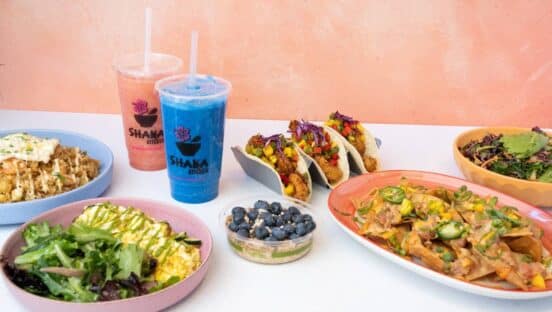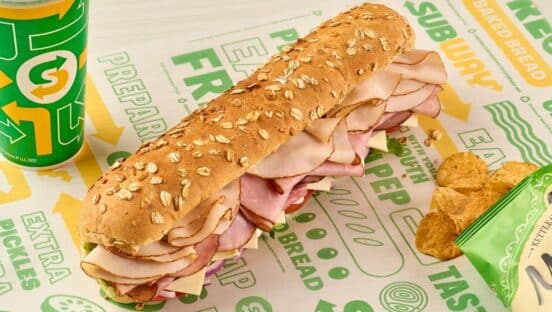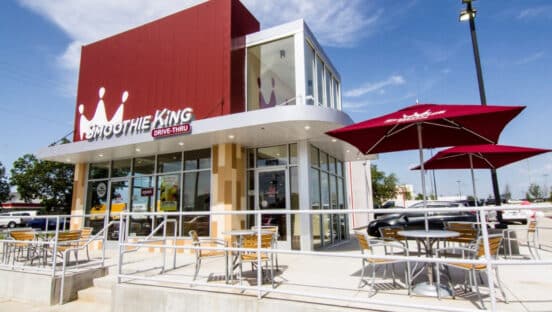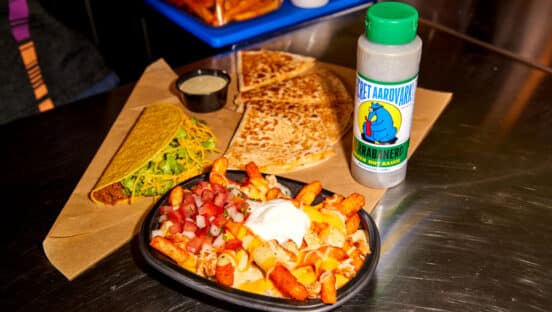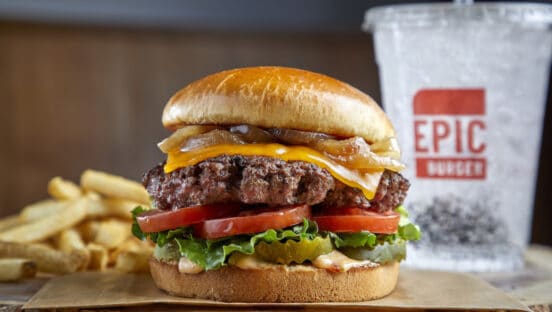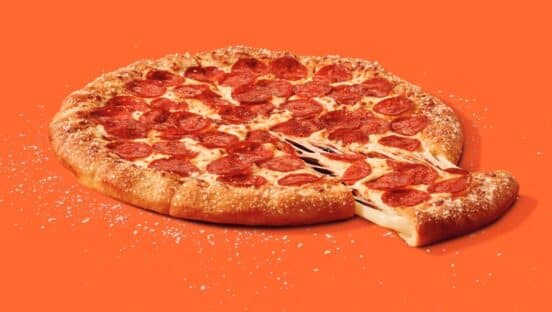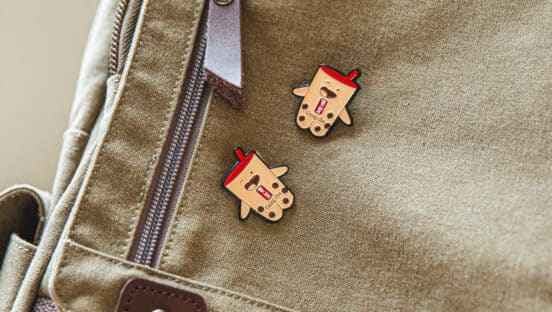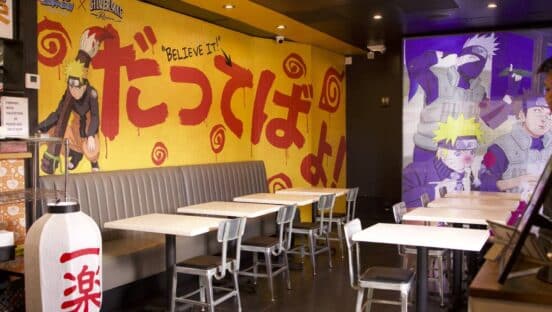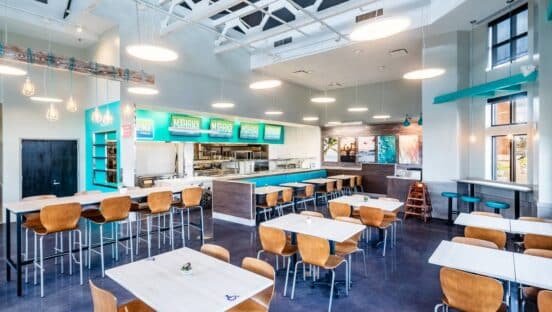Jim Grote’s Donatos chain had a special ingredient that attracted McDonald’s—but
how is the alliance panning out?
by Charlie Fletcher
As a thirteen-year-old, Jim Grote got a glimpse into the pizza business he’ll
never forget.
The year was 1957. “I was delivering newspapers, and I wanted to get some
steadier work,” says Grote. He was offered a job slicing pepperoni with a paring
knife and shredding cheese with a little hand shredder at a brand new pizza
shop. “That,” he says, “is when I really got to learn the pizza business from
the ground up.”
 Grote
Grote
is a keen observer of human behavior, and it didn’t take him long to catch on
to the ins and outs of the pizza business. “The owners were two partners,” he
says. “One was a happy-go-lucky, good-natured guy who made a tremendous product.
The other was a nice guy, but very conservative, who tried to skimp as much
as he could on the product.”
The two operators’ divergent approaches to the pizza business added up to
large differences at the bottom line. “What I saw firsthand,” says Grote, “was
the one who made the really good product and treated the customers in a friendly
way had all the business. It all came on his days. That was a real important
lesson on how important the product was to the business.”
The lesson stuck with him. In 1963, Grote borrowed $1,300 and dropped out
of college to make some dough in his mother’s kitchen. It was a modest beginning,
but it was the start of something that, like bread dough in a warm kitchen,
was bound to expand. It was the birth of Donatos
Pizza, a 148-unit Midwestern pizza chain purchased by McDonald’s
in 1999. Today Grote’s title is founder and executive chairman.
Even more remarkable than Grote’s beginnings in the pizza business was what
made a little chain like Donatos interesting to the Big Mac—the giant of
the quick-service industry. Donatos barely registers in comparison to Pizza
Hut, with more than eight thousand units, or Domino’s, with nearly five thousand.
 |
|
Donato’s
Jim Grote |
The difference, you might say, was in the approach. When Grote opened his first
store, in Columbus, Ohio, in 1963, he applied those principles he had learned
from the ground up as a teenager—and his pizza was a big hit in the neighborhood.
Soon he had more business than he could handle.
That was the point where Jim Grote started down the path that eventually led
him to a meeting with McDonald’s. With a good recipe in hand and lots of help
from family, Grote’s business was an instant success — and an instant slave
master, as he quickly realized that lots of customers and little equipment soon
leads to frustration.
“Friday and Saturday were the busiest nights,” Grote says. “We would work
all week to get those customers in there, and they would end up waiting anywhere
from an hour and a half to two hours for their pizzas. I was making the pizza
by hand in little eighteen-pound batches,” he remembers with a chuckle. “As
I was slicing pepperonis by hand and making dough without a dough mixer one
day, I said, ‘There has got to be a better way!’ Right then I knew I needed
more equipment.”
Even with more equipment, Grote couldn’t keep up with the demand and soon
found partners to open a second restaurant. It was yet another important learning
experience, as he discovered that translating his success to another location
took more than just equipment and a great pizza recipe — it also took training
and performance standards.
| Bill Rose moved from McDonald’s to the top spot at Donatos. “We’re running around here,” he says, “like they were in the early days of McDonald’s.” |
Grote opened his new location, but his partner walked out soon after, leaving
the crew untrained. “The place didn’t work out,” he says, “and I said, before
I open another place, there’s going to be a system in place for everybody to
make pizzas exactly the same way I did in my first store. Before we were really
going to be able to grow, we would have to have the capacity.” That meant enough
equipment to handle the busiest hours on Friday night, along with a system that
made the pizza the same way every time.
Equipment can be purchased from just about anywhere, but the system that Grote
created was truly unique. It was so precise that it took pizza-making out of
the realm of kitchen artistry and landed it in the food chemistry department.
Grote engineered the process with careful precision, designing a special pump
to dispense pizza sauce, weighing ingredients to the hundredth of a pound, and
using machine-kneaded dough that is proofed in special units at the restaurants.
Grote took the same care in designing training standards for his stores. “Our
promise is to serve the best pizza,” says Grote, quoting from his company’s
mission statement—the same quote that’s printed on the back of his business
cards. “The corollary to that is the highest quality product. Everything we
use is, of course, high-quality, but the other part is friendly and honest service,
with a smile, and serving that with people who care.”
| "What I saw firsthand,” says Jim Grote of his first job, “was the operator who made the really good product and treated the customers in a friendly way had all the business.” |
Continuing to draw on personal experience, Grote also had a strong sense of
how his restaurants affected the neighborhoods where they operated. “My first
pizza place was in a residential neighborhood,” he says, “and I lived right
behind our own place. I was very aware of how business could be an intrusion
to the neighborhood.” It became quite apparent to him that when a Donatos unit
goes into a neighborhood, the company needs to be an asset to the neighborhood—creating
a situation, says Grote, “where the neighbors are actually glad we’re there.”
All of this attention to detail was perhaps a factor in the chain’s slow growth.
From 1963 until 1992, Donatos added only about thirty units. Those restaurants,
however, were among the most profitable in the industry.
In 1999, Donatos’ 148 restaurants — about 40 percent of which are franchised
— had average unit volumes of $950,000, as compared to Pizza Hut’s AUV of $696,000,
Domino’s $585,000, and Little Caesars’ $455,000, during the same time period,
according to Technomic, a Chicago-based, food-service consulting firm.
This consistency, attention to detail, and success caught the attention of
McDonald’s, says Bill Rose, Donatos’ president and chief executive officer.
“The fact of the matter is that it was not only the consistency of the product
and the quality of the product, but it was obvious, as the screening took place
for Donatos, that there was a culture here, in terms of the people who worked
in the restaurant,” he says. “It was demonstrable to us from a customer side
that Jim and his organization certainly put people first in terms of the quality
of the training of their managers and their associates in the stores.” Rose
moved to the CEO spot at Donatos in August 1999, after twenty-six years at McDonald’s.
McDonald’s had been shopping for several years, looking for a suitable pizza-concept
purchase opportunity. After investigating more than sixty different pizza businesses,
the company settled on Donatos.
Rose worked with the team of McDonald’s executives who studied the U.S. pizza
market. It wasn’t just a process of reading annual reports. It also involved
a grassroots effort of trying out restaurants from a customer’s point of view.
"We could tell just by the level of service that was being experienced,” he
says, “that there was a high emphasis being placed not just on training and
development, but also on integrity. And it was an operating system that was
replicable.”
Yet the whole idea of purchasing another chain — although not completely
new, after its 1998 purchase of a 20-percent stake in Chipotle Mexican Grill
— was a departure for McDonald’s. “McDonald’s has gone from being a relatively
insular company, in terms of its interaction with the industry, to a much more
open, participating-in-the-industry kind of organization,” says Dennis Lombardi,
executive vice president of Technomic. After years of unsuccessfully trying
to introduce a pizza product in their restaurants, the company finally opted
to buy into the $40-billion-a-year pizza industry, he says. “They’ve moved into
diversification mode.”
“McDonald’s has figured this out — and I think rightly so,” says Rose. “We
and our shareholders are better served if we build a self-reliant, independent
brand that stands on its own. We recognize that it’s very difficult to step
into another food category and bring it into McDonald’s. Either you’re putting
your full-time, best efforts into the hamburger business, or you’re in the pizza
business. When we tried to combine both, we weren’t successful at it. With that
said, obviously McDonald’s saw a great opportunity within Donatos to develop
a concept and work with Jim and the organization here, as we’re doing on a daily
basis, that in its own category can replicate McDonald’s success.”
“Its long-term strategy,” says Lombardi, pointing to the great size differential
between the two companies: McDonald’s, with more than 26,000 restaurants and
annual sales exceeding $40 billion, dwarfs the newly adopted Donatos, with less
than 150 units and 1999 sales of $134 million. “Donatos doesn’t even show up
on the McDonald’s radar screen yet, in terms of a financial event,” Lombardi
says, "but long-term it provides a growth vehicle for them."
It may also be that McDonald’s is seeing the writing on the wall. Many industry
observers say the quick-service segment is largely saturated. “The name of the
game today is more stealing market share than creating a new demand," says Christopher
Volk, president of FFCA, a commercial lender headquartered in Scottsdale, Arizona.
"It’s almost a zero-sum game. If they build a lot of Donatos Pizzas or Chipotle
Mexican Grills, the revenues that they realize are going to come at the cost
of somebody else."
That somebody else won’t be the Pizza Huts and Papa John’s, says Volk. As
Donatos grows, Volk predicts that their market share will come from the independent,
mom-and-pop pizza shops that currently dominate the market. Nonetheless, Volk
says, the dominance by independents was probably an influential factor in McDonald’s
purchase decision.
"Pizza is still for the most part a regional business, and the mom-and-pop
operators represent some of the most formidable competition," says Volk. "To
have a chain like Papa John’s grow the way it has in the last several years,
and yet still have Pizza Hut show some growth in store sales, gives you the
idea that there’s still room in the pizza sector."
Bill Rose isn’t so sure. "Many people have challenged us and said that this
is a saturated industry," he says, "but I believe people are still looking for
great service and great food. The customer is king, and the growth will go to
those who consistently provide customers with what they expect. Everybody knows
that. We all know that we have to execute, and that’s what we’re about."
The question still remains: What will McDonald’s do with Donatos in the future?
Mark Kalinowski, an analyst with Salomon Smith Barney, thinks McDonald’s is
gearing up for an expansion and that the company will have Donatos units coast-to-coast
in the United States by 2005.
It’s an opinion that’s not shared by all industry watchers, however. "I expect
that McDonald’s will be cautious at first, but the company has shown that it
can roll out a lot of restaurants," says Volk. "They have one of the best, if
not the best, real-estate departments in the country, in terms of developing
stores. If you take that and use it as an engine to grow Donatos, they’re capable
of rolling out a significant number of them."
Alan Feldman, president of McDonald’s USA, recently pointed out that the company’s
primary concern is now on testing how the franchise system will work—not
just for Donatos, but also for its other two recently acquired brands, Boston
Market and Chipotle Mexican Grill.
From Rose’s perspective, Donatos is definitely in testing mode. "Right
now we’re just making sure we’re putting the right work-flow processes in place,
putting aces in their places, being very deliberate—not secretive necessarily,
but being very deliberate about what our future development plans are going
to be," he says. "The competition would love to know exactly when, where, and
how we’re doing everything here, because they’re in our restaurants every day
looking at what we’re doing."
By year-end, Rose expects to have opened twenty-two new restaurants in Atlanta,
Cleveland, and Indianapolis. He expects growth to proceed slowly at a rate of
about twenty-five new units a year, expanding in the chain’s existing territory
in the Southeast and Midwest. Most of the expansion will be through company-owned
restaurants, along with a few carefully chosen franchisees.
"If our results achieve our targets," says Rose, "then will get more aggressive
as we move forward."
Nevertheless, even though he’s running fast every day, Rose is having a blast
getting the new, bigger Donatos system off the ground. "I know this is really
corny, but it’s just how Fred Turner, Ray Kroc’s first CEO at McDonald’s, must
have felt," says Rose, who got his start in the pizza business many years ago
before he joined McDonald’s. "We’re running around here like they were in the
early days of McDonald’s. We’ve got a lot of bright young people here, and they’re
working extremely hard to get all the t’s crossed and the i’s dotted. We’re
having a lot of fun and all working very hard."
For Jim Grote, now is a time of allowing others to run the operation he so
carefully put together over nearly forty years. "The fourteen months since the
acquisition have been, for myself and my family, much more than we ever would’ve
dreamed," he says. "I’ve got to tell you, Bill Rose hit the ground running when
he came here, but his experience is well known to the industry, and so is his
ability to grow the company, as he’s done so well at McDonald’s.
"But the main thing is that it’s a match-up in our philosophies and a
match-up in our principles," says Grote. "It seems like he was always ready
to come to Donatos. It’s like he’s been here for ten years, rather than one."
This article originally appeared in the December 2000 issue of QSR. All rights
reserved.

